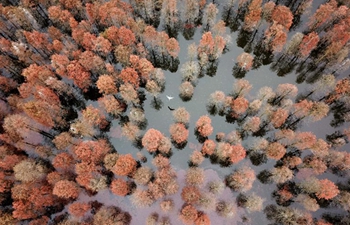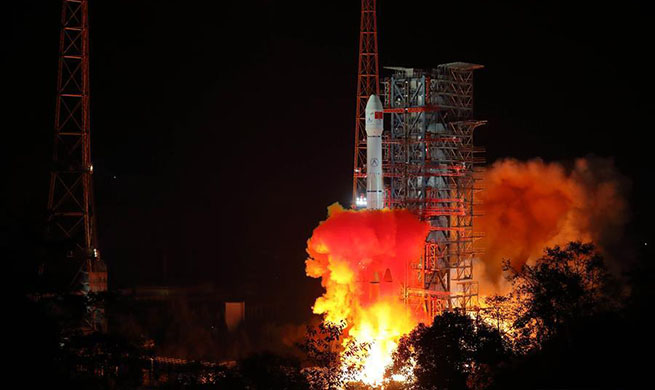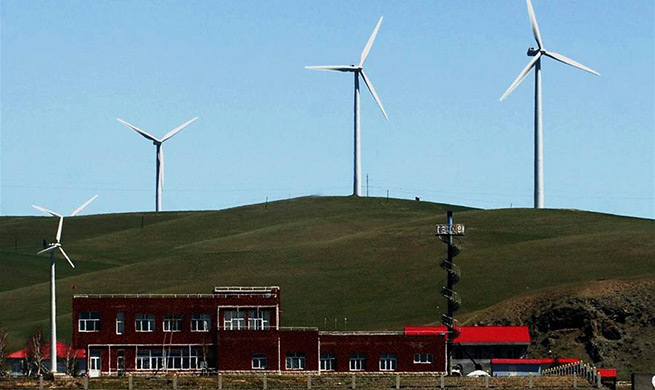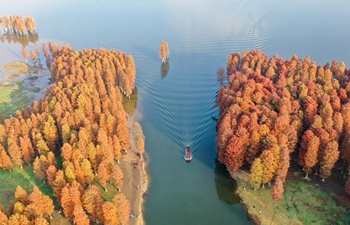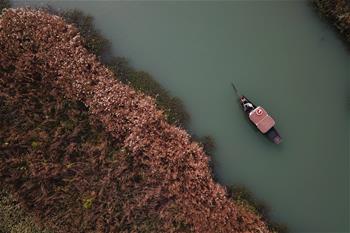by Tan Jingjing
LOS ANGELES, Dec. 7 (Xinhua) -- NASA's InSight lander, which touched down on Mars last week, has captured the first ever sounds of winds on the Red Planet, said NASA on Friday.
NASA's Jet Propulsion Laboratory (JPL) released audio clips of the wind Friday. InSight sensors captured a haunting low rumble caused by vibrations from the wind, estimated to be blowing between 10 to 15 mph (4.5 - 6.7 meters a second) on Dec. 1, from northwest to southeast, according to NASA.
The winds were consistent with the direction of dust devil streaks in the landing area, which were observed from orbit, said NASA.
"This is the first time on the surface of Mars that we've had instruments that can detect up to the frequency that humans can hear," said Tom Pike, a scientist on the InSight project who focuses on the sensors, told a press briefing unveiling the recording.
Bruce Banerdt, InSight principal investigator at JPL in Pasadena, California, said capturing this audio was an unplanned treat. "But one of the things our mission is dedicated to is measuring motion on Mars, and naturally that includes motion caused by sound waves."
"To me, the sounds are really unworldly," Banerdt said. "They do sound like the wind or maybe the ocean roaring in the background, but it also has kind of an unworldly feel to it."
According to NASA, two very sensitive sensors on the spacecraft detected these wind vibrations: an air pressure sensor inside the lander and a seismometer sitting on the lander's deck, awaiting deployment by InSight's robotic arm.
The two instruments recorded the wind noise in different ways. The air pressure sensor, which will collect meteorological data, recorded these air vibrations directly. The seismometer recorded lander vibrations caused by the wind moving over the spacecraft's solar panels, which are each 7 feet (2.2 meters) in diameter and stick out from the sides of the lander like a giant pair of ears.
This is the only phase of the mission during which the seismometer, called the Seismic Experiment for Interior Structure (SEIS), will be capable of detecting vibrations generated directly by the lander, said NASA.
In a few weeks, it will be placed on the Martian surface by InSight's robotic arm, then covered by a domed shield to protect it from wind and temperature changes. It will detect the lander's movement through the Martian surface, said NASA.
SEIS is recording vibrational data that scientists later will be able to use to cancel out noise from the lander when SEIS is on the surface, allowing them to detect better actual marsquakes.
With a reach of nearly 6 feet (2 meters), the arm of inSight will be used to pick up science instruments from the lander's deck, gently setting them on the Martian surface at Elysium Planitia, the lava plain where InSight touched down.
The arm will use its Instrument Deployment Camera, located on its elbow, to take photos of the terrain in front of the lander. These images will help mission team members determine where to set SEIS and heat flow probe, the only instruments ever to be robotically placed on the surface of another planet, said NASA.
Another camera, called the Instrument Context Camera, located under the lander's deck, will also offer views of the workspace.
"We had a protective cover on the Instrument Context Camera, but somehow dust still managed to get onto the lens," said Tom Hoffman of JPL, InSight's project manager. "While this is unfortunate, it will not affect the role of the camera, which is to take images of the area in front of the lander where our instruments will eventually be placed."
Placement is critical, and the team is proceeding with caution. It will take two to three months before the instruments have been situated and calibrated, according to NASA.
InSight landed safely on Mars on Nov. 26, kicking off a two-year mission to explore the deep interior of the Red Planet.








